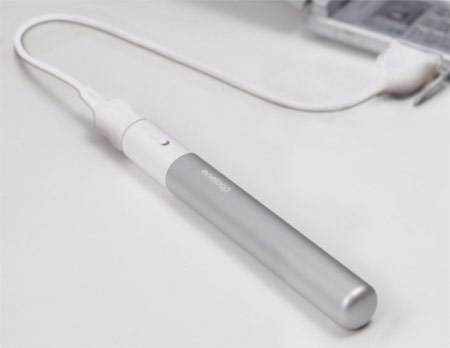Sanyo's Eneloop Stick Booster Provides Anytime/Anywhere Juice To USB Gizmos
Let's face it: just about any gizmo worth using these days has a USB connector, and more often than not, it's actually charged over USB as well. But also, battery life has sunk in recent years as devices are made to be slimmer and hold less spacious batteries. The solution to this quandary? Sanyo's Eneloop Stick Booster, of course!
For those unaware, the Eneloop line of rechargeable batteries have been around for a little while, and those that use them tend to swear by them. If you're alread on the Eneloop bandwagon, this product shouldn't be a tough sell. Basically, the Eneloop Stick Booster is a tube that holds a pair of AA Eneloop batteries. When your USB-related gizmo needs a boost, you simply plug this in and flip it on. Once the Eneloop batteries run dry, you just recharge them, rinse and repeat. They'll be shipping in the US this December, though pricing still seems to be up in the air.

For those unaware, the Eneloop line of rechargeable batteries have been around for a little while, and those that use them tend to swear by them. If you're alread on the Eneloop bandwagon, this product shouldn't be a tough sell. Basically, the Eneloop Stick Booster is a tube that holds a pair of AA Eneloop batteries. When your USB-related gizmo needs a boost, you simply plug this in and flip it on. Once the Eneloop batteries run dry, you just recharge them, rinse and repeat. They'll be shipping in the US this December, though pricing still seems to be up in the air.

With its USB port, KBC-D1AS easily charges various mobile devices*3 such as mobile phones, portable game units, and personal audio devices. Regular emergency chargers that use dry cells to charge mobile phones may not be able to properly charge certain phones that require high current for charging. Thanks to SANYO’s output control technology however, the KBC-D1AS can provide a steady charge to devices that require high current, such as the iPhone*5, by regulating the charge current sent to the device. The Handy Power Source has a slide switch to turn the charge output on and off, as desired.
The KBC-D1AS features a stick-type aluminum body design. With a diameter of less than two centimeters, and weighing just 76 grams with batteries installed, the slim and lightweight design makes it perfect in all kinds of situations such as business and pleasure trips, or commuting.
This product comes packaged with two new ‘eneloop’ batteries*6 that can be recharged about 1,500 times*7 offering the industry’s No.1*8 reusability. They can charge various mobile devices more easily than dry cells, as they deliver a steady high current. Even after the recharging lifespan of the batteries has been reached, they are easy to replace.

